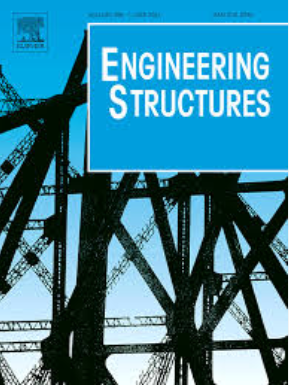Effect of eccentricity and off-axis on tensile failure behavior of UD-CFRP plates: Experimental investigation, failure mechanism, and strength model
IF 6.4
1区 工程技术
Q1 ENGINEERING, CIVIL
引用次数: 0
Abstract
This study examines the tensile behavior of unidirectional CFRP plates under coupled eccentricity and off-axis, addressing a critical gap in understanding the effect of installation-induced imperfections on the tensile performance of CFRP plates. Experiments and finite element analysis (FEA) reveal that an eccentricity ratio of 0.4 reduces tensile capacity by up to 23.66 %, and increasing off-axis angles further degrade performance. Coupled loading leads to mixed-mode failure involving fiber-matrix interface shear, highlighting a significant tension-shear coupling effect. A predictive model is proposed, and strict tolerance limits are recommended: the eccentricity ratio should not exceed 0.06, and the off-axis angle should remain below 0.013 radians.
偏心和离轴对UD-CFRP板拉伸破坏行为的影响:试验研究、破坏机制和强度模型
本研究考察了单向CFRP板在偏心和离轴耦合下的拉伸行为,解决了在理解安装缺陷对CFRP板拉伸性能影响方面的一个关键空白。实验和有限元分析表明,偏心比为0.4时,拉伸性能降低23.66 %,离轴角的增加进一步降低了拉伸性能。耦合加载导致纤维-基体界面剪切的混合模式破坏,突出了显著的拉-剪耦合效应。提出了一种预测模型,并提出了严格的公差限制:偏心比不超过0.06,离轴角不超过0.013弧度。
本文章由计算机程序翻译,如有差异,请以英文原文为准。
求助全文
约1分钟内获得全文
求助全文
来源期刊

Engineering Structures
工程技术-工程:土木
CiteScore
10.20
自引率
14.50%
发文量
1385
审稿时长
67 days
期刊介绍:
Engineering Structures provides a forum for a broad blend of scientific and technical papers to reflect the evolving needs of the structural engineering and structural mechanics communities. Particularly welcome are contributions dealing with applications of structural engineering and mechanics principles in all areas of technology. The journal aspires to a broad and integrated coverage of the effects of dynamic loadings and of the modelling techniques whereby the structural response to these loadings may be computed.
The scope of Engineering Structures encompasses, but is not restricted to, the following areas: infrastructure engineering; earthquake engineering; structure-fluid-soil interaction; wind engineering; fire engineering; blast engineering; structural reliability/stability; life assessment/integrity; structural health monitoring; multi-hazard engineering; structural dynamics; optimization; expert systems; experimental modelling; performance-based design; multiscale analysis; value engineering.
Topics of interest include: tall buildings; innovative structures; environmentally responsive structures; bridges; stadiums; commercial and public buildings; transmission towers; television and telecommunication masts; foldable structures; cooling towers; plates and shells; suspension structures; protective structures; smart structures; nuclear reactors; dams; pressure vessels; pipelines; tunnels.
Engineering Structures also publishes review articles, short communications and discussions, book reviews, and a diary on international events related to any aspect of structural engineering.
 求助内容:
求助内容: 应助结果提醒方式:
应助结果提醒方式:


